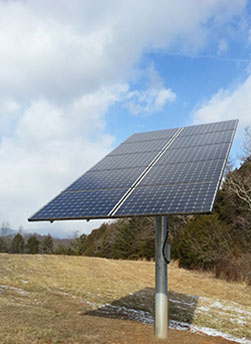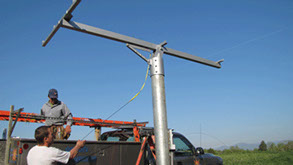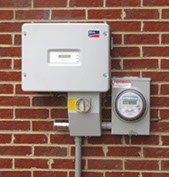


SEARCH MyCVEC
CVEC Solar Project:
CVEC Solar Demonstration
 With a growing interest in renewable energy, many CVEC members have considered installing a photovoltaic or solar energy generation system. So, CVEC decided to install a 2 kilowatt system at the Cooperative headquarters and share our experience with Co-op members.
With a growing interest in renewable energy, many CVEC members have considered installing a photovoltaic or solar energy generation system. So, CVEC decided to install a 2 kilowatt system at the Cooperative headquarters and share our experience with Co-op members.
With installation completed, the CVEC solar system started generating electricity on April 13, 2010. Typically, the system gets rolling around 10 AM and may keep producing energy up until dinner on sunny summer days. (You can view the photovoltaic system real time information at the links to the right. They will all open in a new window.)
Notice that the system never operates at the full 2 kw capacity and fluctuates dramatically with the weather. During a good hour, the system is replacing about 18¢ worth of electric service at 2012 rates.
Also, notice that the system is peaking near 1.6 KW around early afternoon and that the prime generation hours are from 10 AM to 4 PM during summer hours. Since this graph only gives you a continuous snapshot of energy output, the question becomes how much energy per hour or per day would it provide to my home or business, measured in kilowatt-hours (energy output over time).
After deciding that we were interested in a demonstration project, we attempted to follow the path of the typical consumer. We gathered articles about PV technology, searched the Internet for more information, comments and recommendations.

The CVEC Installation:
Choosing the Contractor: After identifying a group of contractors, we contacted seven or eight that were within 75 miles of our site. In addition being able to compare recommendations and products, we wanted to make sure that they would be willing and available to return if our equipment needed servicing.
- Five Photovoltaic professionals visited CVEC to look at our project and discuss options. Most have 15-30 years of experience.
- Some focused on providing guidance, charging for their expertise
as a consultant, then arranging for installation. - Others were more sales oriented following the traditional process
of helping the customer select a system. - Others started as electrical contractors and expanded in the PV installations.
 Mount Systems: CVEC compared roof mount systems to pole mount systems. We chose a stationary pole mount system because we had the space and understood that you may see longer life with better airflow behind the panels. CVEC chose to have the contractor install the pole in a very large concrete foundation and have them trench from the PV system to the service entrance to CVEC Headquarters. We also chose a stationary system rather than one that followed the sun due to cost and service considerations of a mechanical tracking device.
Mount Systems: CVEC compared roof mount systems to pole mount systems. We chose a stationary pole mount system because we had the space and understood that you may see longer life with better airflow behind the panels. CVEC chose to have the contractor install the pole in a very large concrete foundation and have them trench from the PV system to the service entrance to CVEC Headquarters. We also chose a stationary system rather than one that followed the sun due to cost and service considerations of a mechanical tracking device.
Type of Panels: CVEC compared a variety of panels that ranged in price and country of origin
CVEC chose the panels for the cell efficiency, frame strength and expected longevity (20 years guaranteed and 30+ years projected. Others might choose a different panel and be happy with the selection.
Type of Inverter: CVEC chose the SMA Sunny Boy 3000/4000 Inverter which converts the DC (direct current) output of the panels to the AC (alternating current) so that the solar unit can be connected to our circuit breaker panel. Useful life is 10 years guaranteed with 15+ years as a reasonable projection.
CVEC also chose the SMA Webbox to allow us to monitor the system and share the data results with CVEC members.
Turnkey Cost for the 2 KW System? $20,000
![]()
Financing:
We were advised that we might pay $8000 -$10,000 per kilowatt of generation capacity. While the capital costs are very high per kilowatt, the PV system requires no purchased fuel, unlike coal, gas and other electric generation plants. The idea is to recover the investment over time, possibly a very long time.
In addition to government incentives, there are a number of options to help reduce the capital cost of a PV system or generate annual revenue.
Assuming that our system generates 3 megawatt-hours per year, which equals 3000 kilowatt-hours per year, how much are we saving?
As a Virginia utility, CVEC is required to provide a “Net Metering” option to Co-op members generating energy. In short, CVEC provides a credit when a member’s energy generation exceeds their energy consumption. CVEC provides a credit of 12.5¢ per kwh, the effective residential rate.
Another way of offsetting the cost of the PV system is to sell the solar renewable energy credits (SREC’s) through a broker to people who want to support renewable energy by paying an additional fee. SREC’s are a tradable commodity and represent the renewable attributes of solar energy. Some states require a minimum percentage of renewable energy and some individuals are willing to purchase the renewable attributes for personal reasons. SREC’s are sold on the market in 1 MW increments.
Like any commodity, prices are constantly changing and SREC brokers have developed programs to help individuals. These include:
Be advised that CVEC has no knowledge of the long term outcomes of selling SREC’s into another market and is not endorsing the use of an SREC broker.
Recent legislation has enabled CVEC to sell REC’s to members as a CVEC tariff rate. Look for more information in the future as this optional rate is established.
![]()
Incentives:
If you are thinking about investing in renewable energy, then this is a good time if you are interested in government incentives. Currently there are investment tax credits and grants that can help to reduce the cost of a PV system
Federal Tax Credit for Energy Efficiency Investment: A PV system qualifies for a 30% tax credit with no upper limits. That means that the $20,000 PV system would provide a $6,000 tax credit, reducing the initial cost to $14,000. This federal tax credit expires on December 31, 2016. Existing homes & new construction qualify. Both principal residences and second homes qualify. Rentals do not qualify.
![]()
FAQs:
1. The CVEC PV system is rated to generate up to 2 kilowatts(KW) of electric energy at any given moment, but it will likely never reach that mark. Actual energy output is determined by:
• the time of day
• the amount of cloud cover
• the temperature
2. A Megawatt-hour:
• would presently cost CVEC about $45 from our wholesale supplier.
• would light 10,000 hundred-watt lightbulbs for one hour
• equals the standard unit for Renewable Energy Certificates (REC’s)
3. If a kilowatt hour costs:
• 8.5¢ then 3000 kwh’s generated would save: $255 per year.
• 12.5¢ then 3000 kwh’s generated would save: $375 per year
• 16.5¢ then 3000 kwh’s generated would save: $495 per year
4. A Megawatt-hour generated over 100 days also averages 10,000 watt-hours per day, also referred to as 10 kilowatt-hours per day. What could you power in your home with 10 kwh per day? Look at the appliance energy usage chart to see what your PV panels could simultaneously power.
![]()
Safety:
 There are a number precautions that should be observed to ensure that a PV system owner will enjoy the benefits of the generation equipment. CVEC, like other utilities, has specific standards for interconnection to the Cooperative's distribution system to ensure the safety of the public and our dedicated linemen. You can read about our guidelines here.
There are a number precautions that should be observed to ensure that a PV system owner will enjoy the benefits of the generation equipment. CVEC, like other utilities, has specific standards for interconnection to the Cooperative's distribution system to ensure the safety of the public and our dedicated linemen. You can read about our guidelines here.
![]()
Links:
Department of Energy List of REC Marketers
DSIRE – Database of State Incentives for Renewables and Efficiency
USDA REAP Grants – Rural Energy for America Program
View real time stats of the CVEC Solar Project at these links :
HOME | REPORT AN OUTAGE | PAY MY BILL | CONTACT CVEC
Phone: 434.263.8336 | Toll free: 800.367.2832 | Fax: 434.263.8339
Corporate Headquarters:
800 Cooperative Way
Arrington, VA 22922
Payments:
Dept. 1340 | PO Box 2153
Birmingham, AL 35287-1340
Correspondence:
P. O. Box 247
Lovingston, VA 22949
